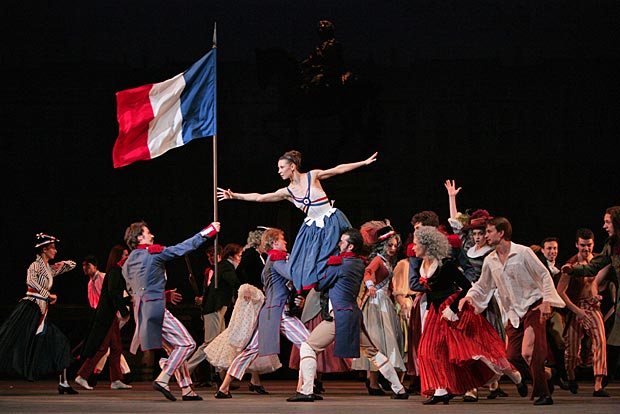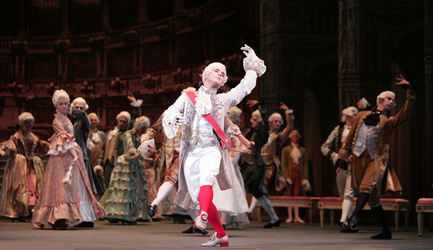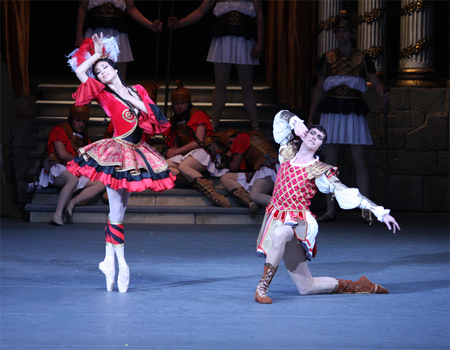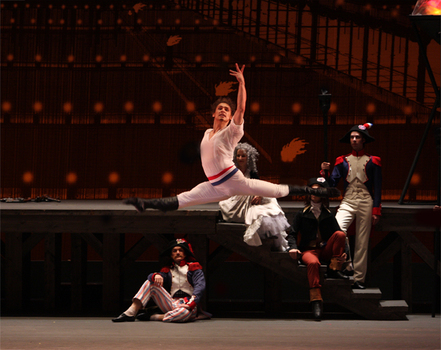The Bolshoi left it till last to be most itself, to dance a ballet that is truly of its blood, its seed - its closing on Alexei Ratmansky's The Flames of Paris will leave much happiness in the memory to override the problematic productions of classics, the unidiomatic Balanchine and the awful backstage events. Here at last, in a work by the most gifted of recent Bolshoi directors, you met on stage young people who dance, who act, who love the theatre, fresh in their performing, skilled in their means, open-hearted in reaching the audience, and loved right back.
The previous night the visiting stars Natalia Osipova and Ivan Vasiliev had raised the roof; for the final performance Vasiliev was there again, but this time with Ekaterina Krysanova, the redhead whose Sleeping Beauty had been so charming, replacing the original Maria Alexandrova (pictured above and below, regrettably injured early in the tour). Without the blinding effect of the Vasipova razzle-dazzle the entire cast could come into focus, and some tremendous performances and company cohesion could be enjoyed. This, like Osipova and Vasiliev, is Ratmansky's generation of dancers.
 The Flames of Paris, despite its French Revolution theme, has Moscow written through it. This 2008 version has travelled a long way from the original Soviet creation of 1932, starring Galina Ulanova who confessed herself utterly bewildered by her role as the actress Mireille de Poitiers. But then the original stars were not individuals but the glorious forces of the Bolshevik revolution. Vasily Vainonen’s vibrantly rhythmic ensemble dances were what whipped up the packed audiences and Josef Stalin himself, but the story insisted on a muddled whirl of characters - Cyril Beaumont’s synopsis of it covered eight pages.
The Flames of Paris, despite its French Revolution theme, has Moscow written through it. This 2008 version has travelled a long way from the original Soviet creation of 1932, starring Galina Ulanova who confessed herself utterly bewildered by her role as the actress Mireille de Poitiers. But then the original stars were not individuals but the glorious forces of the Bolshevik revolution. Vasily Vainonen’s vibrantly rhythmic ensemble dances were what whipped up the packed audiences and Josef Stalin himself, but the story insisted on a muddled whirl of characters - Cyril Beaumont’s synopsis of it covered eight pages.
Ratmansky took enormous liberties with it when, as the embattled but farsighted artistic director of the Bolshoi from 2004 to 2008, he decided to rediscover this Communist totem and renew it as ballet theatre for the new generations of Bolshoi dancers and audiences. He’s retained the flamboyant setpieces of Vainonen’s but added love interest; more courageously, he invented a new narrative momentum that ends with an ominousness that wasn’t there in the original upbeat work that so pleased Stalin.
From this plait of stories emerges not just a lively human momentum inside the grand doings, but a palimpsest of ballet and history
True, it takes a little while in the opening scene to realise that the individual young people will cohere in two sets of lovers, linked by brother and sister Jérôme and Jeanne. Once they’re in place we can suffer and cheer with them in a contemporary-feeling narrative where Vainonen’s popular dances can sparkle and thrill. The added bonus is that this more layered scenario by Ratmansky and his colleague Alexander Belinsky works so well with Boris Asafiev’s jolly score, which expertly amasses baroque musical styles that tell their own fun time-warp story.
Now the original heroine Mireille de Poitiers complements the young people’s emotional narrative with her own malleable symbolism, as a gorgeous theatrical actress who can be hired to embody this or that metaphor, whoever pays her.
From this plait of stories emerges not just a lively human momentum inside the grand doings, but a thought-provoking palimpsest of ballet and history, the myths taken from baroque and Soviet times as well as the 18th century - a many-stranded sparky mixture of the art of the Bolshoi, athletic, satirical, fresh.
 The first scene takes a while to get going and set up the characters, but one's soon conquered by the fierce energy of the street dances. The switch to the pomp and gold-plating of the court scene (pictured right) is a blinder, with dazzling dresses, plumes and wigs shinily lit, amid which brightness Ratmansky’s fatigued courtiers offer the Bolshoi dancers much performing fun. King Louis XVI insists, amid the old-school gavottes, on showing his new pet dance: a contorted peasant stomp that’s almost a dance equivalent of “let them eat cake”, his wife’s famous put-down.
The first scene takes a while to get going and set up the characters, but one's soon conquered by the fierce energy of the street dances. The switch to the pomp and gold-plating of the court scene (pictured right) is a blinder, with dazzling dresses, plumes and wigs shinily lit, amid which brightness Ratmansky’s fatigued courtiers offer the Bolshoi dancers much performing fun. King Louis XVI insists, amid the old-school gavottes, on showing his new pet dance: a contorted peasant stomp that’s almost a dance equivalent of “let them eat cake”, his wife’s famous put-down.
 Then we slide into another time-layer, into the allegorical divertissement that is being shown to the court, performed by the famous Parisian thespians, Mireille de Poitiers and Antoine Mistral (pictured, Ekaterina Shipulina and Vladimir Neporozhny, © Elena Fetisova).
Then we slide into another time-layer, into the allegorical divertissement that is being shown to the court, performed by the famous Parisian thespians, Mireille de Poitiers and Antoine Mistral (pictured, Ekaterina Shipulina and Vladimir Neporozhny, © Elena Fetisova).
On the page this seems all too much to take in, and early Bolshoi performances drew its humorousness too ponderously. But with this set of performers the scene sprang mockingly to life, a very merry entertainment.
Hail Kristina Kretova, a Mireille de Poitiers of utmost glamour and wit, a thesp to her fingertips. In their Armida and Rinaldo ballet, she and the treasurably spineless Artem Ovcharenko gauged the balance of parody and truth to perfection. Kretova was memorably amusing trying ineptly to whip up her witch’s cauldron (“Hey, I’m a goddess, not a stagehand”), coughing when the smoke finally appears. In the final scene, she switched immaculately to embodying the totemic Marianne of the revolutionaries. It was joyously rich acting and comedic sense, coupled with the nuanced dancing accomplishment we saw from her Princess Florine in the Sleeping Beauty. Kretova is a prize girl, and so was the fluttering Chinara Alizade as Amour. This kind of natural stagecraft and deft character-playing is the Bolshoi’s personality (and makes you see why Frederick Ashton fits in in Moscow - some of the playing could come from The Dream).

Ivan Vasiliev as Philippe (pictured above by Elena Fetisova) once again makes one laugh with wonder at his joie de vivre, his exultant enjoyment of his job, flying about the stage at improbable altitude milking the audience winningly; and Krysanova, if not the lightning force that Osipova is, produced fizzing technical excitement to accompany her gentler interpretation.
Denis Savin’s Jérôme was a boyish figure of utmost sincerity, crushed by the death of his aristocratic love, the beauteous Anna Rebetskaya. As her father the Marquis I can’t imagine better than Ruslan Skvortsov, whose dark wuthering brows and jutting chin perfectly complement the white periwig, but who also knows how to walk a villain's walk with sexually interesting menace. Praise also to Denis Medvedev’s Louis XVI, the Marseillaise trio of men led by Igor Tsvirko, and the entertaining Alexei Loparevich (previously a splendid Carabosse) as MC.
This was the real Bolshoi, not disguising, not pretending, being its vivid, conquering self. Till we meet again.
Watch Vasiliev, Osipova and Denis Savin lead the thrilling Vainonen Basque Dance in the Bolshoi's DVD of The Flames of Paris














Add comment